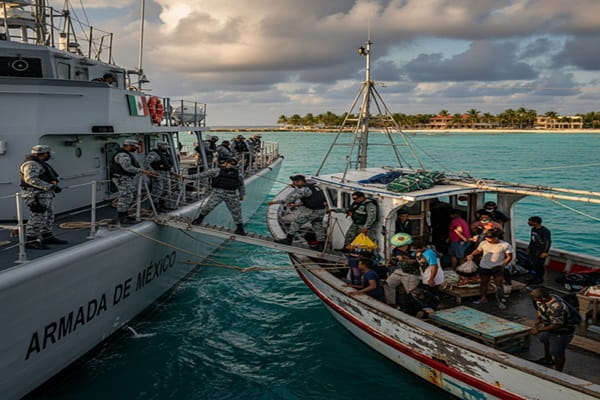Isla Mujeres might look like paradise on Earth—with its turquoise waters, swaying palms, and some of the most breathtaking beaches in Mexico—but life here isn’t always as calm as it seems. Beyond the postcard-perfect sunsets, there’s another story unfolding on these seas: ship interception operations.
At first glance, it may sound like something straight out of a movie, but in reality, these missions are serious business. They’re about saving lives, protecting the ocean, and keeping the local community safe. Whether it’s rescuing people in distress or preventing illegal activities, these efforts represent the heart of Isla Mujeres’ resilience and humanity.
So, let’s dive into why ship interception in Isla Mujeres matters, what goes on behind the scenes, the challenges rescue teams face, and how you can be part of this lifesaving mission.
Why Ship Interception Matters in Isla Mujeres
For many, the ocean is freedom, but it can also be unforgiving. Sudden storms, equipment failure, or even human trafficking attempts can turn a journey into a nightmare. That’s where interception operations step in.
Here’s why they’re so important:
-
They save lives. Quick rescues ensure people stranded at sea get immediate medical help or protection.
-
They protect the environment. By stopping unsafe or illegal vessels, authorities help safeguard Isla Mujeres’ delicate marine ecosystem.
-
They build trust. Locals feel safer knowing there’s a system in place, which encourages more people to report emergencies.
Simply put, without these operations, the risks in open waters would be far greater—for both residents and visitors.
The Rescue and Transfer Process: How It Works
Ship interception might sound like an action-packed chase across the waves, but in reality, it’s a carefully coordinated process.
-
Detection: Authorities use radar and maritime patrols to spot suspicious or distressed vessels.
-
Assessment: They quickly evaluate the situation—where the ship came from, how many people are onboard, and if there’s an immediate threat.
-
Deployment: Rescue teams head out with boats equipped for emergencies. They carry medical kits, communication tools, and trained personnel ready for anything.
-
Interception: Once they reach the ship, officials check documents, offer aid if needed, and determine the next steps.
-
Transfer to Authorities: Rescued individuals are handed over to local authorities who can provide further care or take legal action if required.
What makes Isla Mujeres unique is the blend of law enforcement and humanitarian work. The goal isn’t just to enforce rules—it’s to protect lives and give people hope.
The Heroes Behind the Scenes
When you picture rescue operations, you might think of coast guards or military personnel. But in Isla Mujeres, the circle is wider.
-
Local fishermen are often the first responders, using their deep knowledge of the waters.
-
Community volunteers help organize resources, from blankets to bottled water.
-
International partners provide support with technology and training.
Together, they form a safety net that keeps the seas around Isla Mujeres more secure.
The Biggest Challenges Rescue Teams Face
It’s not all smooth sailing. Ship interception teams encounter challenges that test their skill and determination daily.
-
Unpredictable weather: Strong currents and sudden storms can make rescues dangerous.
-
Treacherous waters: Isla Mujeres is surrounded by reefs and shallow spots that are difficult to navigate during emergencies.
-
Communication barriers: Coordinating between multiple authorities—sometimes across different countries—can slow things down.
-
Emotional toll: Rescuers witness heartbreaking situations, from stranded families to victims of trafficking.
-
Limited resources: Funding is often tight, which means equipment and technology aren’t always up to the task.
Despite these obstacles, the teams push forward, often risking their own safety to protect others.
Stories of Hope: When Rescues Change Lives
Every successful interception has a ripple effect. Beyond saving lives, these rescues unite the community and inspire hope.
-
Fishermen lending a hand: Many times, locals spot troubled boats first and rush to help even before authorities arrive.
-
Community education: After big rescues, workshops on maritime safety often pop up, helping locals and visitors prepare for emergencies.
-
Youth inspiration: Stories of heroism inspire younger generations to volunteer or even pursue careers in marine safety.
-
Shared humanity: Families who’ve been saved often share their stories, bridging cultural divides and bringing people together.
These aren’t just rescues—they’re moments that strengthen Isla Mujeres’ identity as a place of compassion and courage.
How You Can Support Ship Interception Efforts
Even if you’re not on the island, there are plenty of ways to support these life-changing operations:
-
Donate: Local organizations often rely on donations to buy rescue equipment, fuel, and medical supplies.
-
Spread awareness: Share stories online to raise visibility for these crucial efforts.
-
Volunteer: If you live in or visit Isla Mujeres, many groups welcome extra hands for training, events, or even direct support.
-
Advocate: Push for stronger maritime safety regulations and better funding for coastal protection.
Every bit of support counts. Whether you’re contributing time, money, or simply spreading the word, you’re helping save lives.
Also Read : Denver Nuggets vs Timberwolves Match Player Stats
Looking Ahead: The Future of Ship Interception in Isla Mujeres
As technology improves, so do interception strategies. Better radar systems, stronger boats, and international cooperation promise to make future rescues faster and safer.
But at its core, ship interception in Isla Mujeres will always be about people—those risking their lives at sea, and those onshore working tirelessly to protect them.
The community’s resilience, combined with growing awareness, ensures these missions will continue to evolve, making Isla Mujeres not just a paradise for tourists but also a symbol of safety and solidarity.
Final Thoughts: A Story of Courage at Sea
Isla Mujeres may be known worldwide for its beaches and coral reefs, but its story runs deeper than that. Ship interception here isn’t just about rules or regulations—it’s about humanity, heroism, and hope.
-
It’s about saving people who thought all was lost.
-
It’s about local fishermen dropping everything to help strangers.
-
And it’s about communities uniting for the greater good.
So, the next time you picture Isla Mujeres, don’t just think of its stunning coastline. Remember the brave men and women who guard those waters, ensuring that for every life at risk, there’s also a chance for rescue.
Because in Isla Mujeres, the ocean doesn’t just separate—it connects.
Isla Mujeres might look like paradise on Earth—with its turquoise waters, swaying palms, and some of the most breathtaking beaches in Mexico—but life here isn’t always as calm as it seems. Beyond the postcard-perfect sunsets, there’s another story unfolding on these seas: ship interception operations.
At first glance, it may sound like something straight out of a movie, but in reality, these missions are serious business. They’re about saving lives, protecting the ocean, and keeping the local community safe. Whether it’s rescuing people in distress or preventing illegal activities, these efforts represent the heart of Isla Mujeres’ resilience and humanity.
So, let’s dive into why ship interception in Isla Mujeres matters, what goes on behind the scenes, the challenges rescue teams face, and how you can be part of this lifesaving mission.
Why Ship Interception Matters in Isla Mujeres
For many, the ocean is freedom, but it can also be unforgiving. Sudden storms, equipment failure, or even human trafficking attempts can turn a journey into a nightmare. That’s where interception operations step in.
Here’s why they’re so important:
-
They save lives. Quick rescues ensure people stranded at sea get immediate medical help or protection.
-
They protect the environment. By stopping unsafe or illegal vessels, authorities help safeguard Isla Mujeres’ delicate marine ecosystem.
-
They build trust. Locals feel safer knowing there’s a system in place, which encourages more people to report emergencies.
Simply put, without these operations, the risks in open waters would be far greater—for both residents and visitors.
The Rescue and Transfer Process: How It Works
Ship interception might sound like an action-packed chase across the waves, but in reality, it’s a carefully coordinated process.
-
Detection: Authorities use radar and maritime patrols to spot suspicious or distressed vessels.
-
Assessment: They quickly evaluate the situation—where the ship came from, how many people are onboard, and if there’s an immediate threat.
-
Deployment: Rescue teams head out with boats equipped for emergencies. They carry medical kits, communication tools, and trained personnel ready for anything.
-
Interception: Once they reach the ship, officials check documents, offer aid if needed, and determine the next steps.
-
Transfer to Authorities: Rescued individuals are handed over to local authorities who can provide further care or take legal action if required.
What makes Isla Mujeres unique is the blend of law enforcement and humanitarian work. The goal isn’t just to enforce rules—it’s to protect lives and give people hope.
The Heroes Behind the Scenes
When you picture rescue operations, you might think of coast guards or military personnel. But in Isla Mujeres, the circle is wider.
-
Local fishermen are often the first responders, using their deep knowledge of the waters.
-
Community volunteers help organize resources, from blankets to bottled water.
-
International partners provide support with technology and training.
Together, they form a safety net that keeps the seas around Isla Mujeres more secure.
The Biggest Challenges Rescue Teams Face
It’s not all smooth sailing. Ship interception teams encounter challenges that test their skill and determination daily.
-
Unpredictable weather: Strong currents and sudden storms can make rescues dangerous.
-
Treacherous waters: Isla Mujeres is surrounded by reefs and shallow spots that are difficult to navigate during emergencies.
-
Communication barriers: Coordinating between multiple authorities—sometimes across different countries—can slow things down.
-
Emotional toll: Rescuers witness heartbreaking situations, from stranded families to victims of trafficking.
-
Limited resources: Funding is often tight, which means equipment and technology aren’t always up to the task.
Despite these obstacles, the teams push forward, often risking their own safety to protect others.
Stories of Hope: When Rescues Change Lives
Every successful interception has a ripple effect. Beyond saving lives, these rescues unite the community and inspire hope.
-
Fishermen lending a hand: Many times, locals spot troubled boats first and rush to help even before authorities arrive.
-
Community education: After big rescues, workshops on maritime safety often pop up, helping locals and visitors prepare for emergencies.
-
Youth inspiration: Stories of heroism inspire younger generations to volunteer or even pursue careers in marine safety.
-
Shared humanity: Families who’ve been saved often share their stories, bridging cultural divides and bringing people together.
These aren’t just rescues—they’re moments that strengthen Isla Mujeres’ identity as a place of compassion and courage.
How You Can Support Ship Interception Efforts
Even if you’re not on the island, there are plenty of ways to support these life-changing operations:
-
Donate: Local organizations often rely on donations to buy rescue equipment, fuel, and medical supplies.
-
Spread awareness: Share stories online to raise visibility for these crucial efforts.
-
Volunteer: If you live in or visit Isla Mujeres, many groups welcome extra hands for training, events, or even direct support.
-
Advocate: Push for stronger maritime safety regulations and better funding for coastal protection.
Every bit of support counts. Whether you’re contributing time, money, or simply spreading the word, you’re helping save lives.
Looking Ahead: The Future of Ship Interception in Isla Mujeres
As technology improves, so do interception strategies. Better radar systems, stronger boats, and international cooperation promise to make future rescues faster and safer.
But at its core, ship interception in Isla Mujeres will always be about people—those risking their lives at sea, and those onshore working tirelessly to protect them.
The community’s resilience, combined with growing awareness, ensures these missions will continue to evolve, making Isla Mujeres not just a paradise for tourists but also a symbol of safety and solidarity.
Final Thoughts: A Story of Courage at Sea
Isla Mujeres may be known worldwide for its beaches and coral reefs, but its story runs deeper than that. Ship interception here isn’t just about rules or regulations—it’s about humanity, heroism, and hope.
-
It’s about saving people who thought all was lost.
-
It’s about local fishermen dropping everything to help strangers.
-
And it’s about communities uniting for the greater good.
So, the next time you picture Isla Mujeres, don’t just think of its stunning coastline. Remember the brave men and women who guard those waters, ensuring that for every life at risk, there’s also a chance for rescue.
Because in Isla Mujeres, the ocean doesn’t just separate—it connects.





